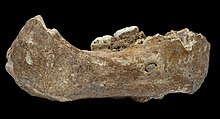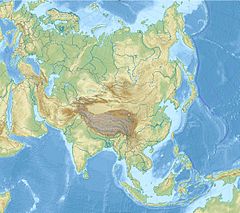Xiahe mandible
 | |
| Common name | Xiahe mandible |
|---|---|
| Species | Denisovan |
| Age | 160,000 years |
| Place discovered | Gansu,China |
| Date discovered | 1980 |
TheXiahe mandible([ɕjâxɤ̌],sh'ya-khuh) is ahomininfossil jaw (mandible) discovered inBaishiya Karst Cave,located on the northeastern edge of theTibetan PlateauinXiahe County,Gansu,China.By the use ofpalaeoproteomic analysis,it is the first confirmed discovery of aDenisovanfossil outside ofDenisova Cave,and the most complete confirmed Denisovan fossil. This fossil discovery shows thatarchaic homininswere present in a high-altitude, low-oxygen environment around 160,000 years ago.Discover,Science NewsandNovaall named the discovery of the mandible in their lists of Top Science Stories of 2019.
History
[edit]The Xiahe mandible was discovered in 1980 in theBaishiya Karst Cave,located on the northeastern edge of theTibetan PlateauinXiahe County,Gansu, China. It was found by a Tibetan Buddhist monk who wasmeditatingin the cave. He passed the bone toJigme Tenpe Wangchug,the sixthGungthangtulku,who recognized it as an important hominin fossil and gave it to geologist Dong Guangrong ofLanzhou Universityin the 1980s.[1][2][3]Dong and his colleagueChen Fahuresearched the mandible, but it was so unusual that they did not know how to classify it. As their research focus was geology and not palaeoanthropology, the fossil was overlooked for decades.[1][3]
In 2010, Chen and his Ph.D. studentZhang Dongjubegan to study the bone together with Dong and surveyed a number of caves in the Xiahe area. As so much time had passed since its initial discovery, it took them six years to ascertain that the fossil came from Baishiya Karst Cave.[4][3]As the cave is a Buddhist sanctuary, the excavation was further delayed by the need to obtain permits from the relevant religious and cultural authorities. In 2018, Zhang and her colleagues finally conducted a systematic excavation of the cave and discovered numerousPalaeolithictools and animal bones bearing cut marks.[2][3]The Lanzhou University team reached out toJean-Jacques Hublinat theMax Planck Institute for Evolutionary Anthropology.Hublin and his Ph.D. student Frido Welker joined the research and helped identify the mandible as Denisovan using protein analysis.[2]
Findings
[edit]| Recent human family tree |
| According to Niet al.2021[5](note, Xiahe andDenisovansare most closely related toNeanderthalsaccording tonDNAandancient proteinanalyses by Chenet al.2019.[6]) |
The Xiahe mandible consists of the right half of a partial mandible with two attachedmolars.[7]The mandible was covered with acarbonatecrust.Uranium-series datingof the carbonate crust places the mandible at over 160,000 years old.[7]It predatesNwya Devu,hitherto the earliest known human presence in a high-altitude, low-oxygen environment, by about 120,000 years.[1][3]
Researchers failed in their attempts toextract DNAfrom the fossil. However, they succeeded in identifying surviving ancientproteomein thedentineof one of the molars of the fossil; the Xiahe proteome shares a closestphylogeneticmatch to that of thehigh coverageDenisovan fossil from Denisova Cave,Denisova 3.[7]Protein analysis also shows that the Xiahe mandible exhibits a single amino acidpolymorphism,COL1α2 R996K, that is only shared by one other specimen on record,Denisova 3;this polymorphism is not found in any other ancient or modern reference population. The mandible also exhibits a single amino acid polymorphism, COL2α1 E583G, that is unique to itself.[8]By way of protein analysis, researchers concluded that the Xiahe specimen belonged to a population that was closely related to the Denisovan specimens from Denisova Cave.[9]This is the first time that an ancient hominin was successfully identified using only protein analysis.[10]It is the most complete known Denisovan fossil.[10]This fossil discovery adds supporting evidence for the notion that archaic hominins were successful in adapting to a high-altitude, low-oxygen environment.[7][2]
The Xiahe mandible and its teeth exhibit generalmorphologythat is typical ofMiddle Pleistocenehominin fossils. Researchers describe the mandible as being "very robust". The Xiahe mandible shares one obvious trait, large teeth, that is similar to the Denisovan fossils on record from Denisova Cave. The mandible also shows morphological similarities to some later East Asian fossils such asPenghu 1.[7][10]
Importance
[edit]Discover,Science NewsandNovaall named the discovery of the mandible in their lists of Top Science Stories of 2019.[11][12][13]
References
[edit]- ^abcGibbons 2019.
- ^abcdHublin 2019.
- ^abcdeWu 2019.
- ^He 2019.
- ^Ni, X.; Ji, Q.; Wu, W.; et al. (2021)."Massive cranium from Harbin in northeastern China establishes a new Middle Pleistocene human lineage".Innovation.2(3): 100130.Bibcode:2021Innov...200130N.doi:10.1016/j.xinn.2021.100130.PMC8454562.PMID34557770.S2CID236784246.
- ^Chen, F.;Welker, F.; Shen, C.-C.; et al. (2019)."A late Middle Pleistocene Denisovan mandible from the Tibetan Plateau"(PDF).Nature.569(7756): 409–412.Bibcode:2019Natur.569..409C.doi:10.1038/s41586-019-1139-x.PMID31043746.S2CID141503768.
- ^abcdeChen et al. 2019.
- ^Chen et al. 2019,(Supplementary).
- ^Max-Planck-Gesellschaft2019.
- ^abcWarren 2019.
- ^Scharping, Nathaniel (31 December 2019)."Denisovan Research Reveals That Early Humans Were More Complex Than We Thought".Discover Magazine.Retrieved25 February2020.
- ^"Top 10 stories of 2019: A black hole picture, measles outbreaks, climate protests and more".Science News.16 December 2019.Retrieved25 February2020.
- ^"The top 10 science stories of 2019".www.pbs.org.Retrieved25 February2020.
Sources
[edit]- Chen, Fahu;Welker, Frido; Shen, Chuan-Chou; Bailey, Shara E.; Bergmann, Inga; Davis, Simon; Xia, Huan; Wang, Hui; Fischer, Roman; Freidline, Sarah E.; Yu, Tsai-Luen; Skinner, Matthew M.; Stelzer, Stefanie; Dong, Guangrong; Fu, Qiaomei; Dong, Guanghui; Wang, Jian; Zhang, Dongju; Hublin, Jean-Jacques (1 May 2019)."A late Middle Pleistocene Denisovan mandible from the Tibetan Plateau"(PDF).Nature.569(7756). Springer Science and Business Media LLC: 409–412.Bibcode:2019Natur.569..409C.doi:10.1038/s41586-019-1139-x.ISSN0028-0836.PMID31043746.S2CID141503768.
- Gibbons, Anne (1 May 2019)."First fossil jaw of Denisovans finally puts a face on elusive human relatives".Science | AAAS.Retrieved1 May2019.
- He, Liping (2 May 2019)."Trung quốc học giả lĩnh hàm phát hiện hạ hà đan ni tác ngõa nhân: 16 vạn niên tiền đăng thượng thanh tàng cao nguyên".The Paper(in Chinese).
- Hublin, Jean-Jacques(1 May 2019)."How We Found an Elusive Hominin in China".SAPIENS.Retrieved2 May2019.
- "First hominins on the Tibetan Plateau were Denisovans".Max-Planck-Gesellschaft.11 April 2019.Retrieved1 May2019.
- Warren, Matthew (1 May 2019)."Biggest Denisovan fossil yet spills ancient human's secrets".Nature.569(7754): 16–17.Bibcode:2019Natur.569...16W.doi:10.1038/d41586-019-01395-0.PMID31043736.S2CID141503756.
- Wu, Bin (2 May 2019)."Giá khối cốt đầu lai tự nhất cá thần bí nhân chủng, chứng minh 16 vạn niên tiền cổ nhân loại dĩ đăng thượng thanh tàng cao nguyên".Sohu(in Chinese).Retrieved2 May2019.

